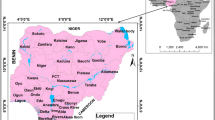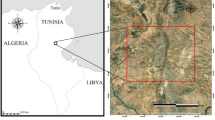Abstract
Kolkata being a metropolitan city in India has its main municipal solid waste dumpsite situated at Dhapa just adjacent to the East Kolkata Wetlands (Ramsar site). The current prevalent situation at Dhapa is open dumping leading to various contaminations and hazards putting forth the need to look for alternative sites where the landfiilling operation can be shifted to using scientific methods. A user interface (UI)–based analytical hierarchy process (AHP) tool has been developed within the Google Earth Engine (GEE) cloud platform to find out the alternative dumping sites using geospatial layers. AHP function is not available as a native algorithm or developed by any researcher in GEE. The tool has three major functionalities, of which the first one handles the UI elements. The AHP procedure is within another function, and the last function integrates the AHP coefficients to the layers generating the final suitability layer. Users can also upload comparison matrix as GEE asset in the form of CSV file which gets automatically integrated into the AHP to calculate the coefficients and consistency ratio to generate the spatial suitability layers. This approach showcases a generalized AHP function within the GEE environment, which has been done for the first time. The tool is designed in the cloud platform which is dynamic, robust and suitable for use in various AHP-based suitability analysis in environmental monitoring and assessment.



(source: Google Earth)




Similar content being viewed by others
Data availability
The datasets generated during and/or analysed during the current study are available from the corresponding author on reasonable request. However, most of the datasets are available publicly in Google Earth Engine data catalog.
References
Acharya, P., Biradar, C., Louhaichi, M., Ghosh, S., Hassan, S., Moyo, H., & Sarker, A. (2019). Finding a suitable niche for cultivating cactus pear (Opuntia ficus-indica) as an integrated crop in resilient dryland agroecosystems of India. Sustainability, 11(21), 5897.
Alanbari, M. A., Al-Ansari, N., Jasim, H. K., Knutsson, S., & Qadaa, A.-M. (2014). Landfill site selection using GIS and multicriteria decision analysis. Engineering, 06(09), 526–549.
Ali, A. S. K., & Ahmad A. (2019). Analysis of chemical and heavy metal concentrations of leachates and impact on groundwater quality Near Dhapa Dumping Ground, Kolkata. Asian Profile, Vol. 47, No. 1.
Ali, A. S. K., & Ahmad, A. (2020). Suitability analysis for municipal landfill site selection using fuzzy analytical hierarchy process and geospatial technique. Environmental Earth Science, 79, 227. https://doi.org/10.1007/s12665-020-08970-z
Alkaradaghi, K., Ali, S.S, Nadhir, A.A, Laue, J., & Chabuk, A. (2019). Landfill site selection using MCDM methods and GIS in the Sulaimaniyah Governorate, Iraq, Environmental Behaviour and Collective Decision Making. https://doi.org/10.3390/su11174530
Amani, M., Ghorbanian, A., Ali, S. A., & Mohammad, K. (2020). Google Earth Engine cloud computing platform for remote sensing big data applications: A comprehensive review. IEEE Journal of Selected Topics in Applied Earth Observations and Remote Sensing. https://doi.org/10.1109/JSTARS.2020.3021052
Center for International Earth Science Information Network - CIESIN - Columbia University. (2018). Gridded population of the world, Version 4 (GPWv4): Population density, Revision 11. Palisades, NY: NASA Socioeconomic Data and Applications Center (SEDAC). https://doi.org/10.7927/H49C6VHW
Chabuk, J. A., Al-Ansari, N., Hussain, M. H., Knutsson, S., & Pusch, R. (2017). GISbased assessment of combined AHP and SAW methods for selecting suitable sites for landfill in Al-Musayiab Qadhaa, Babylon, Iraq. Environmental Earth Sciences, Article 209.
Fuentes, I., Padarian, J., Ogtrop, F. V., & Vervoort, R. W. (2019). Comparison of surface water volume estimation methodologies that couple surface reflectance data and digital terrain models, Water, vol. 11, no. 4, Art. no. 780.
Funk, C., Pete, P., Martin, L., Diego, P., James, V., Shraddhanand, S., Gregory, H., James, R., Laura, H., Andrew, H., & Joel, M. (2015). The climate hazards infrared precipitation with stations—A new environmental record for monitoring extremes. Scientific Data, 2, 150066. https://doi.org/10.1038/sdata.2015.66
Gorelick, N., Hancher, M., Dixon, M., Ilyushchenko, S., Thau, D., & Moore, R. (2017). Google earth engine: Planetary-scale geospatial analysis for everyone. Remote Sensing of Environment, 202, 18–27.
Kaur, J., & Shekhar, C. (2020). Multimodal medical image fusion using deep learning. Advances in Computational Techniques for Biomedical Image Analysis. https://doi.org/10.1016/B978-0-12-820024-7.00002-5
Kim, K. R., & Owens, G. (2010). Potential for enhanced phytoremediation of landfills using biosolids—A review. Journal of Environmental Management, 91(4), 791–797.
KMC. (2010). Methane to market: Assessment report. https://www.globalmethane.org/Data/1128_Dhapa.Assessment.Report.4–27–10.pdf
Kumar, L., & Mutanga, O. (2018). Google Earth Engine applications since inception: Usage, trends, and potential. Remote Sensing, vol. 10, no. 10, Art. no. 1509.
Marcomini, A., Suter II, G. W., & Critto, A. (Eds.). (2008). Decision support systems for risk-based management of contaminated sites. Springer Science & Business Media.
Matejczyk, M., Paza, G. A., Naêcz-Jawecki, G., Ulfig, K., & Markowska-Szczupak, A. (2011). Estimation of the environmental risk posed by landfills using chemical, microbiological and ecotoxicological testing of leachates. Chemosphere, 82(7), 1017–1023.
Nath, S. K., Adhikari, M. D., Maiti, S. K., Devaraj, N., Srivastava, N., & Mohapatra, L. D. (2014). Earthquake scenario in West Bengal with emphasis on seismic hazard microzonation of the city of Kolkata, India. Natural Hazards and Earth System Sciences, 14(9), 2549–2575.
Paoli, L., Corsini, A., Bigagli, V., Vannini, J., Bruscoli, C., & Loppi, S. (2012). Long-term biological monitoring of environmental quality around a solid waste landfill assessed with lichens. Environmental Pollution, 161, 70–75.
Peter, B. G., Messina, J. P., Lin, Z., & Snapp, S. S. (2020). Crop climate suitability mapping on the cloud: A geovisualization application for sustainable agriculture. Scientific Reports, 10(1), 1–17.
Ravanelli, R. (2018). Monitoring the impact of land cover change on surface urban heat island through Google Earth Engine: Proposal of a global methodology, first applications and problems. Remote Sensing, vol. 10, no. 9, Art. no. 1488.
Saaty, T. L. (1980). The Analytic Hierarchy Process. McGraw-Hill.
Swain, K. C., Singha, C., & Nayak, L. (2020). Flood susceptibility mapping through the GIS-AHP technique using the cloud. ISPRS International Journal of Geo-Information, 9(12), 720.
Wang, L., Yan J., & Ma, Y. (2019). Cloud computing in remote sensing. Chapman and Hall/CRC ISBN: 978–1138594562. https://doi.org/10.1201/9780429488764
WBPCB. (2015). Environmental and social management plan for containment of Dhapa Dumpsite Final Report.
Yalew, S. G., Van Griensven, A., & van der Zaag, P. (2016). AgriSuit: A web-based GIS-MCDA framework for agricultural land suitability assessment. Computers and Electronics in Agriculture, 128, 1–8.
Author information
Authors and Affiliations
Corresponding author
Ethics declarations
Conflict of interest
The authors declare no competing interests.
Additional information
Publisher's Note
Springer Nature remains neutral with regard to jurisdictional claims in published maps and institutional affiliations.
Rights and permissions
About this article
Cite this article
Bhattacharya, S., Ghosh, S. & Bhattacharyya, S. Analytical hierarchy process tool in Google Earth Engine platform: a case study of a tropical landfill site suitability. Environ Monit Assess 194, 276 (2022). https://doi.org/10.1007/s10661-022-09878-w
Received:
Accepted:
Published:
DOI: https://doi.org/10.1007/s10661-022-09878-w




